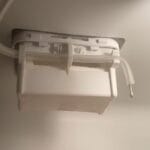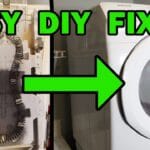Imagine you’re all set to tackle your outdoor chores, but your trusty Cub Cadet lawn tractor refuses to move. Frustration mounts as you try to figure out why your hydrostatic transmission isn’t cooperating.
You’re not alone—this is a common issue that many Cub Cadet owners face. But before you let panic set in or call for expensive repairs, take a deep breath. There are several simple reasons why your machine might be acting up, and even better, there are practical solutions you can try on your own.
You’ll discover the key causes and straightforward fixes that can get your Cub Cadet back in action. Read on to transform your mechanical woes into a triumph.

Credit: www.youtube.com
Common Causes Of Hydrostatic Transmission Issues
The Cub Cadet hydrostatic transmission won’t move? You may face this issue due to several common causes. Understanding these can help identify and solve the problem. Hydrostatic transmissions rely on fluid dynamics to operate efficiently. If any part malfunctions, it can impact the tractor’s movement. Let’s explore these causes.
Low Hydraulic Fluid Levels
Hydraulic fluid is vital for transmission performance. Low fluid levels can hinder movement. Without enough fluid, the transmission loses pressure. This affects its ability to power the wheels. Regularly check fluid levels to ensure proper operation. Keeping them topped up prevents many issues.
Air In The Hydraulic System
Air pockets can form in the hydraulic system. Air reduces efficiency and causes erratic movement. Bleeding the system removes trapped air. It restores smooth operation. Regular maintenance prevents air from entering. This keeps the transmission working well.
Clogged Filters
Filters keep the hydraulic system clean. Dirt and debris can clog them over time. Clogged filters restrict fluid flow, impacting performance. Cleaning or replacing filters ensures smooth fluid movement. This helps maintain optimal transmission function. Regular checks keep filters clean and effective.

Credit: www.tiktok.com
Troubleshooting Steps
Dealing with a Cub Cadet hydrostatic transmission that won’t move can be frustrating. It’s important to understand the basic troubleshooting steps to identify the root of the problem. Addressing these issues early can prevent further damage and ensure smooth operation.
Checking Fluid Levels
Low fluid levels can hinder transmission movement. Make sure the fluid reservoir is filled to the correct level. Use the recommended type of transmission fluid specified by the manufacturer. Incorrect fluid can cause further issues. Regular checks help maintain optimal performance.
Inspecting For Air Bubbles
Air bubbles in the system can disrupt transmission function. To check, observe the fluid reservoir for signs of bubbling. Bleed the system to remove trapped air. This process helps restore proper fluid circulation. Efficient fluid movement is crucial for the transmission to work correctly.
Examining Filters
Clogged filters can block fluid flow, affecting transmission movement. Inspect filters for dirt and debris. Clean or replace filters as needed to ensure fluid can pass freely. Regularly maintaining filters enhances transmission efficiency. A clear path for fluid is vital for seamless operation.
Fixing Transmission Problems
Is your Cub Cadet hydrostatic transmission acting up? Don’t worry, you’re not alone. Many owners face this issue, but fixing it can be easier than you think. Addressing transmission problems often involves straightforward steps that you can do yourself, saving you time and money. Let’s dive into some practical solutions.
Refilling Hydraulic Fluid
Your transmission relies on hydraulic fluid for smooth operation. Low fluid levels can lead to movement issues. Check the fluid level by locating the dipstick or reservoir on your Cub Cadet.
Add hydraulic fluid if it’s below the recommended level. Use the fluid type specified in your owner’s manual. Regularly checking and refilling keeps your transmission in top shape.
Bleeding The System
Air trapped in the hydraulic system can disrupt the transmission. Bleeding the system removes air, ensuring proper function. Start by parking your mower on a flat surface and turning off the engine.
Locate the bleed valve, usually near the transmission. Follow the manual’s instructions to release air until fluid flows steadily. This simple step can dramatically improve your mower’s performance.
Replacing Clogged Filters
Filters keep the hydraulic fluid clean, but over time, they can get clogged. A clogged filter restricts fluid flow and hampers transmission movement. Check the filters regularly for debris or wear.
If they’re clogged, replace them with new ones. Ensure you’re using the correct filter type for your model. Keeping filters clean prolongs your transmission’s lifespan and enhances efficiency.
Have you ever wondered how a simple maintenance task can prevent costly repairs down the road? Regularly addressing these transmission issues can transform your Cub Cadet experience from frustrating to smooth and reliable. What’s your go-to fix for transmission problems? Share your tips in the comments!

Credit: www.reddit.com
Preventative Maintenance Tips
Regular maintenance keeps your Cub Cadet’s hydrostatic transmission moving smoothly. Check fluid levels and inspect for leaks often. Clean debris from the transmission area to ensure efficient operation.
Preventative maintenance is key to keeping your Cub Cadet hydrostatic transmission in top shape. Regular checks can prevent costly repairs and extend the machine’s life. By following these simple tips, you ensure smooth operation and reliability. Let’s explore some essential maintenance practices.Regular Fluid Checks
Checking the fluid level is crucial. Low fluid can lead to transmission issues. Always use the recommended fluid type for your model. Consult the user manual for guidance. Regular checks help maintain optimal performance. A simple yet effective step.Keeping The System Clean
Debris can hinder transmission function. Keep the system free from dirt and grass. Regular cleaning prevents build-up and ensures smooth operation. Use a soft brush or cloth. Avoid water spray directly on sensitive parts. Clean equipment runs better.Scheduled Filter Changes
Filters trap dirt and contaminants. Over time, they become clogged. Change filters as recommended in the manual. This ensures fluid flows freely. A fresh filter keeps the system efficient. Schedule changes to avoid potential problems. Simple steps for a smooth ride.When To Seek Professional Help
When your Cub Cadet hydrostatic transmission refuses to move, it can be frustrating. You might try a few fixes yourself. But sometimes the problem is beyond simple solutions. Knowing when to seek professional help can save time and prevent further damage. Understanding the signs of complex issues and knowing your warranty options are crucial. Let’s explore these in detail.
Identifying Complex Issues
Some problems are not easy to spot. Strange noises or leaks may indicate complex issues. If you notice these, it may be time to consult a professional. They have the tools and knowledge to identify hidden problems. Addressing these early can prevent costly repairs.
Understanding Warranty Options
Check if your Cub Cadet is still under warranty. This can save you money. Warranties often cover transmission issues. Contact the manufacturer or dealer for warranty details. They can guide you on repair processes. Taking advantage of warranty options is wise and economical.
Essential Tools For Repair
Experiencing issues with your Cub Cadet hydrostatic transmission can be frustrating. Understanding the essential tools for repair can save time and effort. Proper tools ensure the job is done efficiently. Addressing hydrostatic transmission problems requires specific equipment. These tools make the process smoother.
Hydraulic Fluid Types
Choosing the right hydraulic fluid is crucial. It impacts performance and longevity. Cub Cadet transmissions need compatible fluids. Check the manual for recommended types. Quality fluids prevent wear and enhance efficiency. Incorrect fluid can lead to damage.
Filter Replacement Kits
Filters keep the transmission clean. Replacement kits are essential for maintenance. Regular filter changes prevent blockages. They ensure smooth operation of the transmission. Kits come with everything needed for a quick swap. Easy installation keeps your transmission in top shape.
Frequently Asked Questions
Why Won’t My Cub Cadet Move?
Check for transmission fluid leaks. Low fluid can cause movement issues. Inspect belts and pulleys for damage.
How Do I Fix A Hydrostatic Transmission?
Regularly change the fluid. Ensure the filter is clean. Replace damaged belts or parts promptly.
Is A Faulty Belt Causing No Movement?
Yes, a worn-out or broken belt can prevent movement. Check belts for wear or damage.
Can Low Fluid Affect Transmission?
Absolutely, low fluid levels can hinder movement. Always maintain proper fluid levels for smooth operation.
What Are Signs Of Transmission Issues?
Unusual noises, sluggish movement, or fluid leaks. These can indicate transmission problems needing attention.
Conclusion
Fixing a stuck Cub Cadet transmission is often straightforward. Always check the basics first. Inspect fluid levels regularly. Ensure the drive belt is intact. Clean and clear any debris. Test the foot pedal for proper function. Seek professional help if problems persist.
Regular maintenance prevents future issues. Keep your machine running smoothly. Enjoy hassle-free mowing all season long. Remember, a little attention goes a long way. Your Cub Cadet deserves the best care. Stay proactive with your equipment. Troubleshooting becomes easier with practice.
Your lawn will thank you for it. Reliable performance awaits your efforts.




